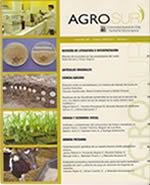SOIL DECOMPACTNESS IN APPLE ORCHARDS (Malus domestica Borkh.) UNDER IRRIGATION IN THE UPPER VALLEY OF RIO NEGRO -ARGENTINA
Main Article Content
Abstract
The aim of this study was to evaluate the effect of decompactness on soil physical [penetration resistance (Pr), infiltration rate (I), % water content (%W), bulk density (Ds)], chemical [total organic carbon (TOC), pH] and biological [microbial biomass carbon (MBC), dehydrogenase, activity (DHA) soil microbial respiration (SMR), phosphotriesterase (P), metabolic efficiency (MBC/TOC)] properties in both Typic Haplocambid (PI) and Typic Torrifluvent (PII) soils cultivated with apple crops during 60 years (T). Soils were decompacted and replanted (Rep) in both plantation rows (F) and with machinery tracks (H) during the period 2005/2006. Decompacted soils were evaluated using soil penetration resistance and PI soils responded positively to this factor. However, both PI and PII soils were considered as limiting for root growing plants, mainly the control soils (T), and subsoiling did not prevent the re-compaction in the H soils. The highest values of TOC were detected in PII and in both dismantled and re-planted soils (PI and PII).
The input of TOC was higher in both dismantling and replanting soils of PII. Moreover, in PI soil the effect of decompacness was not significant, maybe because the clay content in the soil could have some protection on the soil organic matter. Finally, the resistance to penetration plus the determination of total organic carbon and biological tests such as carbon of microbial biomass, dehydrogenase and respiration of the soil, were most sensitive to detect the impact of agricultural practices carried out under the conditions of this study.

